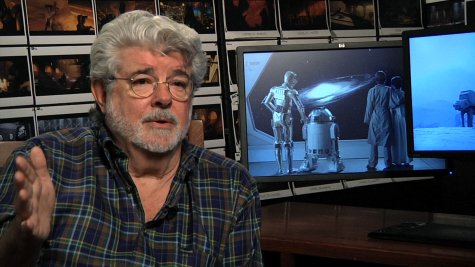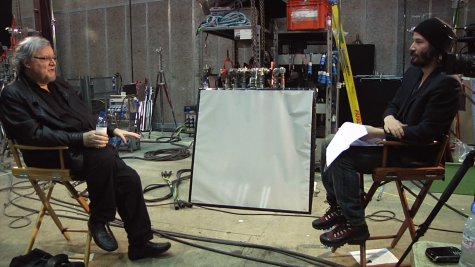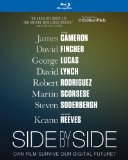| Reviews & Columns |
|
Reviews DVD TV on DVD Blu-ray 4K UHD International DVDs In Theaters Reviews by Studio Video Games Features Collector Series DVDs Easter Egg Database Interviews DVD Talk Radio Feature Articles Columns Anime Talk DVD Savant Horror DVDs The M.O.D. Squad Art House HD Talk Silent DVD
|
DVD Talk Forum |
|
|
| Resources |
|
DVD Price Search Customer Service #'s RCE Info Links |
|
Columns
|
|
|
Side by Side
New Video // Unrated // February 5, 2013
List Price: $29.95 [Buy now and save at Amazon]
Side by Side doesn't seek to crown a victor. The question isn't whether or not CCD chips are superior to celluloid, though the documentary does explore both sides of the digital vs. film arguments. The fact of the
matter is that the transition to digital has been underway for quite a number of years now, and 35mm film -- both as an acquistion format and certainly as a delivery method -- is in decline. Side by Side explores the implications of this shift away from century-old photochemical processes and towards endless streams of 0s and 1s. What do we gain? What do we stand to lose? What tradeoffs have to be made? What does the future hold?
If that high-level summary in any way makes Side by Side sound dry or impenetrably technical, rest assured that this is not at all the case. The documentary deftly strikes a balance where it introduces key concepts to the unfamiliar without droning on so long as to bore the initiated. Side by Side doesn't pit two types of cameras against one another; it delves into most every visual aspect of filmmaking, including editing, color timing, visual effects, and even distribution. By exploring the mechanics of filmmaking over time, both analog and digital, its talking points are placed in an intriguingly historical context. As obvious as it seems in retrospect, I honestly hadn't thought about the fact that the actual photography was the last pre-distribution aspect of filmmaking to make the shift to digital. Side by Side features interviews with a great many filmmakers, spanning a number of disciplines, eras of filmmaking, budgetary levels, and countries of origin. Among those interviewed are luminaries like Martin Scorsese and David Lynch, Dogma 95 DV pioneers Lars von Trier and Anthony Dod Mantle, such digital advocates as Robert Rodriguez, Steven Soderbergh, and George Lucas, and celluloid loyalists like Christopher Nolan. Directors whose works run in the nine figures are featured alongside fiercely independent filmmakers shooting on DSLRs with comparative pocket change. As the topic of conversation is the fundamental underpinning of their art, the discussions are intensely passionate.
Make no mistake that this is a conversation. Side by Side doesn't aim its cameras at cinematographers like Wally Pfister, Vilmos Zsigmond, or Vittorio Storaro and bark "go!" The documentary
has a genuine interest in understanding the impact of the digital transition. Host/producer Keanu Reeves is willing to play devil's advocate -- no pun intended -- and pose challenging questions to these many filmmakers. Side by Side makes a concerted effort to pay equal time to those who prefer film and those who prefer digital. The plusses and minuses of both are explored at length on a variety of different levels. For instance, shooting digitally greatly reduces the cost of raw materials, and directors can keep the cameras rolling far longer. On the other hand, not having to swap out mags every ten minutes means actors can get exhausted, and since money isn't rolling through the camera as it does with film, that can have an impact on the cast and crew's discipline. Though the advent of digital photography has democratized filmmaking, it also makes it easier for others to wrest artistic control from directors and cinematographers (not to mention from each other). I'd say the orientation does lean somewhat towards digital, with the analog arguments tending to be more abstract or romantic, but I suppose that's unavoidable with so much of the industry already having embraced that transition.
Side by Side casts a wonderfully wide net, not limiting itself to just how moving images can be captured but what's done with that footage afterwards, from effects to editing to color timing to distribution. It even tackles both sides of the idea of people streaming feature-length movies on their iPhones via Netflix, an aspect of the digital transition I wasn't expecting to be addressed here. It's heartening to see that the topic of archival is not glossed over...that most any film projector can screen a movie shot a hundred days or a hundred years ago, while finicky hard drives and ever-changing standards mean the digital art being created today may be lost to future generations.
As someone who generally whiles every spare moment watching, reading about, or writing about movies, the cynical part of me was expecting Side by Side to reassemble familiar film-versus-digital arguments in a very appealing packaging. The conversations are far wider in scope than I was anticipating, I appreciate its interest in remaining even-keeled while still acknowledging the inevitability of digital's dominance, and there's something to be said for putting all of this in a historical context as well. With as ubiquitous as digital cinematography is anymore, it's easy to forget how unrecognizably different things were just ten years ago, and Side by Side points to the promise and uncertainty the future may hold. Engrossing, surprisingly accessible, and very Highly Recommended.
Video
For whatever reason, I was expecting Side by Side to be polished to a gleaming, cinematic sheen -- the sort of documentary I'd be able to see screened theatrically. Instead, it looks very much like something produced expressly for one of the high-def channels on cable. Side by Side is presented at 1080i, even. Clarity and detail are lackluster, again closer in appearance to something I'd expect to catch on cable. Its lean bitrate struggles to keep up. In a word, the presentation is underwhelming.
Side by Side arrives on a single layer Blu-ray disc. The documentary is presented at its native aspect ratio of 1.78:1 and has been encoded with AVC.
Audio
Side by Side features two 16-bit DTS-HD Master Audio soundtracks: one in stereo and the other in 5.1. I opted for the six-channel mix, not that it's worlds removed from the stereo track. Brief bursts of music fill the surrounds and take advantage of the subwoofer. Some of the films excerpted throughout Side by Side also make modest use of the rear channels, and there are brief splashes of color unique to the documentary itself. By and large, of course, the focus is placed squarely on the filmmakers' conversations. Every last one of them is clear and intelligible, although the recording can be somewhat
uneven. A handful of the participants sound distant and hollow, and one is marred by some light flickers of distortion. Although the inclusion of lossless audio is appreciated, I'm not sure I could tell the difference between this and a 384kbps Dolby Digital 5.1 appearance on cable.
English subtitles are also offered.
Extras
Side by Side comes packaged in a flat slipcover.
The Final Word
Side by Side takes a discussion that could be overly technical inside baseball and approaches it in a way that's both accessible and compelling. The sheer variety of impassioned opinions about the transition from celluloid to digital, perceptions that span many different disciplines and backgrounds, an insistence on asking questions rather than trying to arrive at a predetermined conclusion, the staggering scope of what this shift encompasses, and, of course, a thoroughly impressive selection of directors and cinematographers lending their thoughts: as high as my expectations were for Side by Side, the documentary readily exceeded them. The unremarkable presentation, sparse extras, and limited replay value leave me thinking that Side by Side would be best discovered on Netflix or Amazon Prime, but no matter which method you choose, this documentary comes Highly Recommended.
 |
| [click on the thumbnail to enlarge] |
If that high-level summary in any way makes Side by Side sound dry or impenetrably technical, rest assured that this is not at all the case. The documentary deftly strikes a balance where it introduces key concepts to the unfamiliar without droning on so long as to bore the initiated. Side by Side doesn't pit two types of cameras against one another; it delves into most every visual aspect of filmmaking, including editing, color timing, visual effects, and even distribution. By exploring the mechanics of filmmaking over time, both analog and digital, its talking points are placed in an intriguingly historical context. As obvious as it seems in retrospect, I honestly hadn't thought about the fact that the actual photography was the last pre-distribution aspect of filmmaking to make the shift to digital. Side by Side features interviews with a great many filmmakers, spanning a number of disciplines, eras of filmmaking, budgetary levels, and countries of origin. Among those interviewed are luminaries like Martin Scorsese and David Lynch, Dogma 95 DV pioneers Lars von Trier and Anthony Dod Mantle, such digital advocates as Robert Rodriguez, Steven Soderbergh, and George Lucas, and celluloid loyalists like Christopher Nolan. Directors whose works run in the nine figures are featured alongside fiercely independent filmmakers shooting on DSLRs with comparative pocket change. As the topic of conversation is the fundamental underpinning of their art, the discussions are intensely passionate.
Make no mistake that this is a conversation. Side by Side doesn't aim its cameras at cinematographers like Wally Pfister, Vilmos Zsigmond, or Vittorio Storaro and bark "go!" The documentary
 |
| [click on the thumbnail to enlarge] |
Side by Side casts a wonderfully wide net, not limiting itself to just how moving images can be captured but what's done with that footage afterwards, from effects to editing to color timing to distribution. It even tackles both sides of the idea of people streaming feature-length movies on their iPhones via Netflix, an aspect of the digital transition I wasn't expecting to be addressed here. It's heartening to see that the topic of archival is not glossed over...that most any film projector can screen a movie shot a hundred days or a hundred years ago, while finicky hard drives and ever-changing standards mean the digital art being created today may be lost to future generations.
As someone who generally whiles every spare moment watching, reading about, or writing about movies, the cynical part of me was expecting Side by Side to reassemble familiar film-versus-digital arguments in a very appealing packaging. The conversations are far wider in scope than I was anticipating, I appreciate its interest in remaining even-keeled while still acknowledging the inevitability of digital's dominance, and there's something to be said for putting all of this in a historical context as well. With as ubiquitous as digital cinematography is anymore, it's easy to forget how unrecognizably different things were just ten years ago, and Side by Side points to the promise and uncertainty the future may hold. Engrossing, surprisingly accessible, and very Highly Recommended.
Video
For whatever reason, I was expecting Side by Side to be polished to a gleaming, cinematic sheen -- the sort of documentary I'd be able to see screened theatrically. Instead, it looks very much like something produced expressly for one of the high-def channels on cable. Side by Side is presented at 1080i, even. Clarity and detail are lackluster, again closer in appearance to something I'd expect to catch on cable. Its lean bitrate struggles to keep up. In a word, the presentation is underwhelming.
Side by Side arrives on a single layer Blu-ray disc. The documentary is presented at its native aspect ratio of 1.78:1 and has been encoded with AVC.
Audio
Side by Side features two 16-bit DTS-HD Master Audio soundtracks: one in stereo and the other in 5.1. I opted for the six-channel mix, not that it's worlds removed from the stereo track. Brief bursts of music fill the surrounds and take advantage of the subwoofer. Some of the films excerpted throughout Side by Side also make modest use of the rear channels, and there are brief splashes of color unique to the documentary itself. By and large, of course, the focus is placed squarely on the filmmakers' conversations. Every last one of them is clear and intelligible, although the recording can be somewhat
 |
| [click on the thumbnail to enlarge] |
English subtitles are also offered.
Extras
- Deleted Scenes, Presented by American Express (3 min.; HD): It's not just you; the title makes me cringe too. AmEx didn't really get their money's worth, considering that this reel consists of a pair of short snippets that run two and a half minutes, all told. Robert Rodriguez speaks briefly about how one half of Grindhouse was shot digitally while the other was captured on 35mm, although viewers often confused which medium was used for which segment. Editor Walter Murch also touches on the lack of a shutter in digital projection.
- Additional Interviews with the Filmmakers (14 min.; HD): This second reel is far more substantial, featuring additional comments by Martin Scorsese, Steven Soderbergh, the Wachowskis, David Lynch, Robert Rodriguez, David Fincher, James Cameron, Greta Gerwig, George Lucas, Lena Dunham, and Lars von Trier. Among the topics of conversation are the absurdity of an artist turning up his nose at a new creative concept, the omnipresence of video delivery methods in the age of the iPad, the brain's response to 2D and 3D imagery, and how the democratization of filmmaking has made it more difficult to stand out in an endless sea of movies.
Side by Side comes packaged in a flat slipcover.
The Final Word
Side by Side takes a discussion that could be overly technical inside baseball and approaches it in a way that's both accessible and compelling. The sheer variety of impassioned opinions about the transition from celluloid to digital, perceptions that span many different disciplines and backgrounds, an insistence on asking questions rather than trying to arrive at a predetermined conclusion, the staggering scope of what this shift encompasses, and, of course, a thoroughly impressive selection of directors and cinematographers lending their thoughts: as high as my expectations were for Side by Side, the documentary readily exceeded them. The unremarkable presentation, sparse extras, and limited replay value leave me thinking that Side by Side would be best discovered on Netflix or Amazon Prime, but no matter which method you choose, this documentary comes Highly Recommended.
|
| Popular Reviews |
| Sponsored Links |
|
|
| Sponsored Links |
|
|
| Release List | Reviews | Shop | Newsletter | Forum | DVD Giveaways | Blu-Ray | Advertise |
|
Copyright 2024 DVDTalk.com All Rights Reserved. Legal Info, Privacy Policy, Terms of Use,
Manage Preferences,
Your Privacy Choices | |||||||














